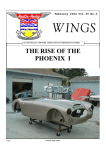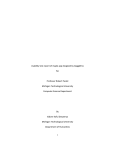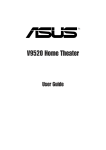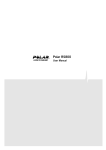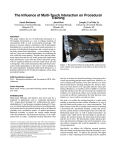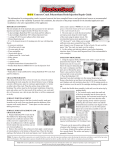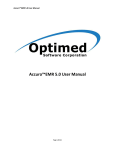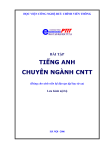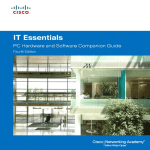Download KeyView [4823353_1.wpd]
Transcript
4823353_1.wpd Page 1 VOLUME: 38 ISSUE NO. 39 MARCH 2006 Calendar of Events I.A.A.I. BC CHAPTER 15 - ANNUAL GENERAL MEETING & CONFERENCE “BACK TO BASICS” March 27th - 30th, 2006 Forster’s Convention Center Kamloops, British Columbia Cost: $400.00 IAAI Members $425.00 Non Members See pages 20-21 for further information and registration details or contact Brian Hollingworth [email protected] Inside this Issue IAAI Chapter 15 - 2006 Executive Members 2 Welcome New Members 3 Associate Membership 3 Ken Snell Retires 3 Hands Across the Border - February 2006 4 Feature Article: Ask the Scientist5 Feature Article: The Shocking Truth About Electrical Products. 6 4823353_1.wpd Feature Article: Seen on Scene 12 Feature Article: The Basics of NFPA 921 & NFPA 1003 for IAAI Members Feature Article: Engineer’s Corner 18 AGM Details and Registration Form 20-21 Application for Membership 23 Page 2 14 4823353_1.wpd Page 3 I.A.A.I. Chapter 15 - 2006 Executive Members PRESIDENT: Ken Snell SJ Fire Investigations E-Mail: [email protected] 1st VICE PRESIDENT: Myles Anderson Victoria Fire Department 2nd VICE PRESIDENT: Mike Bourdon Fire Prevention Officer Langley City Fire Rescue Services, c/o City Hall 20399 Douglas Crescent, Langley, BC V3A 4B3 Phone: (604) 514-2883 | Fax (604) 530-3853 www.city.langley.bc.ca SECRETARY: Terry Zweng Vancouver Fire Department 900 Heatley Avenue, Vancouver, BC V6A 3S7 Phone: (604) 665-6075 Fax: (604) 665-6076 Cell: (604) 603-2435 | Home: (604) 541-9088 Email: [email protected] TREASURER: Eric Laity (ICBC Retired) 5781 Kitchener Street, Burnaby, BC V5B 2J3 Home: (604) 298-7411 E-mail: [email protected] PAST PRESIDENT: Brian Hollingworth ING Western Union Insurance 400 - 2955 Virtual Way, Vancouver, BC V5M 4X6 Phone: (604) 882-3680 Fax: (604) 882-3682 Home: (604) 882-3688 E-mail: [email protected] DIRECTOR: Gordon Gill Richmond Fire Department 6960 Gilbert Road, Richmond, BC V7C 3V4 Phone: (604) 303 2707 Fax: (604) 278-0547 Home: (604) 274-6042 E-mail: [email protected] DIRECTOR: Jim Gallant, RCMP Regional Forensic Laboratory 5201 Heather Street, Vancouver, BC V5Z 3L7 Phone: (604) 264-3431 Fax: (604) 264-3499 E-mail: [email protected] DIRECTOR: Gene Krecsy ICBC/SIU 4399 Wayburne Dr., Burnaby, BC V5G 3X7 Phone: (604) 439-4913 Fax: (604) 438-7549 E-mail: [email protected] DIRECTOR: Ken Holmberg Forensic Investigations PO Box 75449 White Rock, BC V4B 5L5 Phone: (604) 535-6056 | Fax (604) 542-6037 Cel: (604) 787-0963 Email: [email protected] DIRECTOR: Richard Rawlings S.J.I. - Fire Investigator DIRECTOR: Darren Berg CNS Insurance DIRECTOR: Bill Bunt (Vancouver PD, Retired) SJI Fire Investigator E-mail: [email protected] DIRECTOR: Daryl Driemel (Retired) c/o Saanich Fire Department 1094 Gosper Crescent, Victoria, BC V9A 4J3 Phone: (250) 383-1628 Fax: (250) 475-5505 E-mail: [email protected] DIRECTOR: Arnold Archer Royal Sun/Alliance Insurance 700 - 580 Hornby Street Vancouver, BC V6C 3B6 Phone: 604-684-8111 | Fax 604-662-3599 E-mail: [email protected] Home: 604-852-0252 E-mail: [email protected] DIRECTOR: Jeff Bush West Vancouver Fire Department 760 - 16th Street, West Vancouver, BC Phone: 604-925-7370 V7V 3S1 DIRECTOR: Paul Mahill Surrey Fire Service 8676 -132 Street, Surrey, BC Phone: 604-543-6766 DIRECTOR/LEGAL COUNSEL: Richard B. Lindsay c/o Lindsay Kenney 1800 -401 W. Georgia Street Vancouver, BC V6B 5A1 Phone: (604) 687-1323 Fax: (604) 687-2347 E-mail: [email protected] EDITOR/DIRECTOR: Paul A. McDonnell c/o Singleton Urquhart 1200- 925 W Georgia St, Vancouver, BC V6C 3L2 Phone: (604) 682-7474 Fax: (604) 682-1283 E-mail: [email protected] Welcome New Members Attention: Members! The Informer is interested in receiving articles from you for future editions regarding, for example, statistics, local news, personnel movement. Please contact the Editor for 4823353_1.wpd Page 3 The Informer – March 2006 Ken will no longer be licenced or under contract to do on-scene fire investigation work, but will be available to work on existing files through SJ Investigations at 604.929.9329 or [email protected] Ken has enjoyed working fire scenes continuously for over 26 years and has determined that the time has come to lay down his shovel. Ken says that the people he has been blessed with working for and against have made the years challenging and interesting. We wish Ken all the best and a long and happy retirement. HANDS ACROSS BORDER UPDATE THE Page 4 4823353_1.wpd The Informer -- March 2006 Page 4 The 30th Anniversary Hands Across the Border meeting was held on February 10, 2006. Approximately 65 attended the meeting session and another 60 attended the dinner for special guests Past IAAI President Dan Lemiuex and Past Washington State Chapter IAAI President Jerry Anderson, co-founders of “Hands Across the Border”. Also in attendance were IAAI President Kirk Hankins and 2nd Vice President Eileen Stauss. At the dinner, a Presidential Citation was presented by Mr. Hankins in acknowledgment of the “Hands Across the Border” initiative. ASK THE SCIENTIST (Ask the Scientist is a new feature in the IAAI Journal Fire & Arson Investigator, provided by the IAAI Forensic Science Committee. Your questions are invited. Please submit to Ask the Scientist c/o The Fire & Arson Investigator) ASTM Standards related to the analysis of fire debris Standards relating to extraction of evidence (sample preparation) E1385-00 Standard Practice for Separation and Concentration of Ignitable Liquid Residues from Fire Debris Samples by Steam Distillation E1386-00 Standard Practice for Separation and Concentration of Ignitable Liquid Residues from Fire Debris Samples by Solvent Extraction E1388-00 Standard Practice for Sampling of Headspace Vapors from Fire Debris Samples E1412-00 Standard Practice for Separation of Ignitable Liquid Residues from Fire Debris Samples by Passive Headspace Concentration With Activated Charcoal E1413-001 Standard Practice for Page 5 4823353_1.wpd Page 5 The Informer – March 2006 Separation and Concentration of lgnitable Liquid Residues from Fire Debris Samples by Dynamic Headspace Concentration E2154-01 Standard Practice for Separation and Concentration of lgnitable Liquid Residues from Fire Debris Samples by Passive Headspace Concentration with Solid Phase Microextraction (SPME) Standards Relating to Instrumental Analysis E1387-01 Standard Test Method for lgnitable Liquid Residues in Extracts from Fire Debris Samples by Gas Chromatography E1618-01 Standard Test Method for lgnitable Liquid Residues in Extracts from Fire Debris Samples by Gas Chromatography-Mass In its section on physical evidence, NFPA 921 references ASTM standards for the analysis of fire debris. What is ASTM and where did these methods come from? The term "ASTM standards" refers to specific standards that have been published by ASTM International. ASTM International was originally known as the American Society for Testing and Materials (ASTM), and although the name of the organization has changed, its function has not. ASTM International is a not-for-profit voluntary standards development organization. ASTM members, who represent a wide area of specialists, develop standards through the consensus process. ASTM Committee E30 on the Forensic Sciences relies upon the subcommittee E30.01 (Criminalistics) for the development of standards related to the analysis of fire debris for the presence of ignitable liquid residues and many other types of physical evidence. The standards are developed and maintained by experts in the field, representing both public and private Page 6 4823353_1.wpd The Informer -- March 2006 Page 6 laboratory personnel. There are several ASTM methods that may be of interest to the fire investigator. Standards and Guides related to the analysis of fire debris may be divided into two general categories: (1) methods for extracting debris (separating the ignitable liquid residue from the debris, so that it is in a form suitable for instrumental analysis); and (2) methods for instrumental analysis and data interpretation. Additional standards also exist that address other related forensic laboratory procedures, such as documentation and evidence storage. In addition, the Scientific Working Group for Fire and Explosives (SWGFEX) is in the process of developing additional standards for submission to ASTM. The standards under development include a standard for the overall approach to the analysis of fire debris and a standard focusing on quality control issues relevant to fire debris. ASTM documents provide details on how to apply the various techniques that are available to fire debris analysts. The standard practices that describe the various extraction, or sample preparation methods provide detailed explanations of how to use a technique, the quality control measures that should be incorporated, and the limitations and advantages of the technique. Similarly, the standard methods for the instrumental analysis provide guidance for instrument specifications, appropriate quality control measures, and limitations of the techniques. These methods also present a system for classifying ignitable liquids based upon their chemical compositions and boiling point ranges. Another important feature of these standards is their emphasis on correct procedures for data analysis, and descriptions of criteria for the classification of an unknown ignitable liquid residue. In many ways, the pertinent ASTM standards serve the same role for fire debris analysts that the NFPA 921 Guide for Fire and Explosion Investigations serves for cause and origin investigators. It provides a framework for the process, and provides a measure of validity when the recognized procedures are used. The development of ASTM standards follows a process similar to that of the NFPA standards; it is a consensus process, and input from all interested Page 7 4823353_1.wpd Page 7 The Informer – March 2006 Page 8 and knowledgeable parties is encouraged to ensure that the standards reflect good scientific practice like NFPA, ASTM encourages periodic review and revision of all published practices, methods or standards. More information on ASTM International, and information on how to purchase individual standards can be obtained from their website: www.astm.org. This article originally appeared in the January 2005 Edition of Fire & Arson Investigator FEATURE ARTICLE: The Shocking Truth About Electrical Products By Carrie R. Frank and Anne M. Rhodes A 14-year-old boy is excited about starting his freshman year in his new high school. To celebrate, his parents give him money to buy a soft drink, something they rarely have at home. But an ungrounded vending machine in the school cafeteria uses the boy as a conduit for electric current, shocking him and burning his arm. An elderly woman buys an electric blanket to stay warm at night. As she sleeps, flammable insulation on the wires that distribute heat through the blanket begins to smolder. The woman's smoke alarm wakes her, sparing her serious injury. A man stands in his swimming pool, cleaning it with a power washer, when the machine falls into the water. He is electrocuted. A relatively inexpensive ground fault circuit interrupter would have cut the current but was not included on the product, in part to save the manufacturer money. Sadly, cases like these are not unique. Electrical products kill and injure hundreds of people every year. Indeed, electricity can be as dangerous at 35 volts as it is at 10,000 volts. The insulating qualities of human skin usually begin breaking down at 35 volts. Thereafter it takes very little current in the body to be fatal.1 Because most products and household appliances operate on voltages up to 250 volts, they can become deadly if they have design or manufacturing defects or are labeled with inadequate warnings. Common problems include failure to include safety features in products used near water, failure to design products with proper grounding devices, defective circuitry, and inadequate electrical insulation. In fact, injuries like those described above could have been prevented if the corporations that manufactured the products heeded basic design guidelines and incorporated appropriate safety devices as specified in the National Electrical Code (NEC). Used by state and local inspectors to determine if a product or property complies with safety requirements, the NEC provides the most current and complete requirements, guidelines, and practices to ensure the safety of individuals and property from the dangers of electricity. Claims most often associated with electrical product defects include strict liability, negligence, breach of warranty, and premises liability. Because of the inherent danger associated with electricity, claims regarding failure to warn or inadequacy of warnings are often the strongest in electrical product defect litigation. Water hazards Because water and electricity are widely known to be a lethal combination, common sense suggests that a product designed for use with or around water should have safety features that minimize electrocution risks. Surprisingly, many such products, including power washers, contain electrical defects that subject consumers to a high risk of electrocution when using the product in a foreseeable manner. One of these, an industrial power washer manufactured by BrittTech Corp., electrocuted Duane Hardy because of a short circuit in the product's transformer.2 The enclosed base portion of the washer contained a motor and a transformer that converted the 220 volts on which the machine operated into a safer 24 volts carried to switches in the washer's spray handle. The plaintiff's expert testified at trial that pressure from tape outside a terminal protector allowed the protector to contact low-voltage wiring, causing the short. He said that there was inadequate insulation in the product and that, for a small cost, the handle could have been grounded and the switches made safer by enclosing them. These precautions would have prevented Hardy's 4823353_1.wpd The Informer -- March 2006 Page 8 Page 9 death, the expert testified, even in the event of a short in the transformer. The jury returned a verdict for the plaintiff, but BrittTech moved for judgment, arguing that the plaintiff failed to establish that the power washer was unreasonably dangerous at the time of sale and that it had reached Hardy without substantial change in its condition (He bought it from his brother). The company noted that at some point Hardy had taken the handle apart to repair a loose wire, and evidence showed that he did not always use the cover enclosing the motor and transformer. On the basis of this evidence, the trial court granted BrittTech's motion, but the appeals court reversed, saying the plaintiff 's claim was predicated on a defect in the transformer. Even though the trial court determined that Hardy had made changes to the product, the appeals court noted, experts for both the plaintiff and defendant testified that those changes would not have affected the function of the transformer.3 Because the combination of water and electricity is considered an obvious danger, contributory or comparative negligence issues may arise concerning the conductor the injured person. This is well illustrated in the case of Lawrence Lovell Jr., who died after receiving an electric shock from the Blue Lustre Dirt Buster he rented to clean the exterior of his home.4 The Dirt Buster, like the power washer that killed Duane Hardy, was manufactured by BrittTech.5 Because its power cord was only 12 feet long, Lovell used an extension cord, which he Plugged into a three-pronged outlet inside his house and ran through an open window. Lovell then removed his shoes and socks, and as he sprayed his house, puddles of water accumulated around his feet. The connection between the two cords rested in a puddle, and, unbeknownst to Lovell, the outlet he was using was not grounded. The combination of the wet cord connection and ungrounded outlet shocked Lovell and caused fatal cardiac arrest. Lovell's widow brought a wrongful death action based on products liability against the manufacturers, distributors, and lessor of the Dirt Buster, alleging negligence and strict liability. In particular, she argued that the 12-foot power cord was too short, requiring use of an extension cord; that warnings were inadequate because they did not explicitly direct consumers to elevate or tape any connection between the power cord and an extension cord; and that it was foreseeable that consumers would plug the product into ungrounded outlets, as many household outlets are ungrounded. A jury returned a defense verdict, concluding that the product was not unreasonably dangerous and that Lovell had assumed the risk of electrocution. The appeals court upheld the verdict, finding that the use of an extension cord was not inherently dangerous and became so only when Lovell plugged it into an ungrounded receptacle and allowed the connection to lie in a puddle of water. The court held that the safety warning on the machine, which instructed users to waterproof the connection between the power cord and extension cord and to always use a grounded receptacle, was sufficient. It found that taping and elevating the connection were "obvious" remedies "even to a casual consumer" and that the lack of specific reference to these remedies did not make the warning inadequate. The court observed that "it is common knowledge that electricity and water are dangerous in combination, and that water readily conducts electricity."6 Consumer knowledge was also a key factor in Keener v. Dayton Electric Manufacturing Co.,but the court reached a different conclusion about liability.7 In that case, Harold Keener's friend, Joy Hollan, had a sump pump installed in her basement. The pump quit working. After several days of rain, Hollan discovered that her basement was flooded and called Keener for help. With the pump plugged into an electrical outlet, standing ankle deep in water with no rubber gloves or rubber boots, Keener leaned over and lifted the pump from the sump. As the pump cleared the floor, Keener was electrocuted. His wife brought a wrongful death action based on strict liability against the pump's manufacturer. The plaintiff alleged that the product was defective because it was not equipped with a groundwire or an overload protector, which would have prevented her husband's death. Although the defendant argued that Keener was contributorily negligent, the jury returned a verdict for the plaintiff. The appeals court upheld the judgment, holding that lifting the pump out of the water was a reasonably anticipated use of the product. The difference between this holding and the result in Lowell is what the ordinary consumer is charged with knowing. In this case, the issue was whether Keener knew the product lacked important safety features- knowledge consumers are not reasonably expected to possess. Lowell, on the other hand, involved the type of common knowledge expected of consumers. 4823353_1.wpd Page 9 The Informer – March 2006 Page 10 Failure-to-ground defects Electricity always seeks the most conductive path back to its source or to the earth. Grounding adds protection against electrical shock by providing a safe path for electricity to move from a defective product, outlet, fixture, or appliance into the earth, rather than through a person. Without proper grounding, otherwise mundane objects can become deadly. The Ramanauskas family found this out when their 10-year-old son, Shawn, died after being electrocuted while attempting to buy a snack from an ungrounded vending machine. The machine, owned by Lance, Inc., was located in the lobby of a Holiday Inn motel.8 The family brought a products liability suit against Lance, Holiday Inn and Montgomery Coca Cola Bottling Co. which owed the soft drink vending machine adjacent to, and in contract with, the snack vending machine. The premises liability claim against the motel centered on two facts: first, that the motel handyman hardwired the outlet, into which the machines were both plugged, with reversed polarity and without proper grounding; and second, that the hotel management had failed to react to complaints before Shawn's death that both machines were shocking users. 4823353_1.wpd The Informer -- March 2006 Page 10 Page 11 4823353_1.wpd Page 11 The Informer – March 2006 Page 12 Evidence showed that Montgomery Coca-Cola was aware that a user was shocked before Shawn's death at another vending machine in the same motel, that the Coke machine was touching the Lance snack machine at the time of the accident, that the grounding prong of the Coke machine had been removed from its plug, and that Montgomery knew its machines in many locations had shocked customers at least once a year. The plaintiff settled with the motel and Montgomery before trial. The case went to trial against Lance, and a jury awarded damages to the plaintiffs. The company appealed, alleging that the plaintiffs failed to produce substantial evidence that lance owed Shawn a duty of care and that the evidence was insufficient to support submission of the case to the jury to determine punitive damages. The appeals court upheld the verdict on the duty o f care issue, noting that Lance, in its contract with the motel, assumed a duty to keep its vending machine safe. On the question of punitive damages, the court found ample evidence of wanton misconduct, including • • • • Lance employees' lack of knowledge concerning electrical safety and grounding, even after Shawn's death Lance's failure to provide repairs personnel with a $5 tester that would show whether an outlet was properly grounded the fact that none of Lance's 225 machines in the area had been tested for proper grounding Lance's failure to comply with its own corporate safety manual, which required the installer to verify that outlets into which machines are plugged are properly grounded. Further testimony revealed that Lance had done nothing after Shawn's death to ensure that its employees were aware of the warnings and grounding instructions in its safety manual. The adequacy of warnings was the critical issue in the case of Michael Cannon, a repair technician electrocuted by an ungrounded soda vending machine.9 Because the machine's power cord was too short to reach an outlet. an extension cord was used with an adapter. This allowed the three-pronged plug on the vending machine cord to be plugged into the two- pronged extension cord. But the extension cord was attached to the adaptor in a way that its polarity was lost. Further, the adapter had a metal tab designed to be connected to the grounded center screw of a two-pronged wall outlet, but when the adapter is used with an extension cord, there is no way to ground the connection because the adaptor is too far away from the outlet. This dangerous setup left the vending machine ungrounded. When Cannon was called to work on it, he moved the machine away from the wall and brushed against an adjoining candy machine that was grounded' He was electrocuted when the electricity from the ungrounded machine passed through his body to the electrical ground on the candy machine. Cannon's wife filed a wrongful death action against the manufacturer of the vending machine; the municipality that owned the shop where the machine was located (on the basis of premises liability); the shop's operator; and Eagle, the manufacturer of the adapter. The plaintiff settled with all the defendants except Eagle and proceeded to trial against it alleging that it had failed to provide adequate warning and that the adapter had outlived its intended purpose-to bridge the gap between older buildings with two pronged outlets and newer, three pronged products and appliances' The plaintiff contended that although the use of two-pronged outlets is decreasing, the sale of adapters is increasing, showing that consumers are misusing the device and that the adapter is unreasonably dangerous because the risk outweighs its utility. A jury found in favor of Eagle., On appeal, the court upheld the conclusion that the adapter was not unreasonably dangerous per se but reversed on the adequacy of the adapter’s warning. The court noted that manufacturers have a duty to warn against the dangers of product misuse and that there was no dispute that improper use of the adapter, without adequate grounding, was one of the factors contributing to Cannon’s death. Although the adapter complied with Underwriters Laboratories, Inc., warnings, the court found that these requirements were "merely guidelines and not definitive on the issue of the adequacy of warnings." 10 The warning consisted of tiny lettering on the Part of the adapter to be plugged in. This, the court held, was clearly inadequate. Further, the court noted that the warning, which stated "CAUTION: connect tab to grounded screw," did not convey the significant risk of electrocution if the device was not properly grounded. 4823353_1.wpd The Informer -- March 2006 Page 12 Page 13 Circuitry Defects Another cause of electrocution is faulty circuitry, either in equipment such as a circuit breaker panel or in the circuits designed into a product' Such a defect caused the electrocution death of David Bouverette, a journeyman electrician, while he worked on the control panel of an industrial welding machine."11 Electricians rely on circuit breakers to shut off power by breaking the circuit simultaneously when the breaker handle is in the "off" position' In this case, the circuit breaker in the control panel of the welding machine did not do so when used with an external linkage handle. which allows electricians to turn off circuits without opening a circuit box enclosure. The result was continuous power, even though indicator lights suggested that the power was off. Bouverette's wife filed a wrongful death and products liability action against the manufacturers of the machine, control panel, and circuit breaker, alleging negligent design and manufacture, failure to warn, and breach of implied warranty of fitness. The plaintiff proceeded to trial against Westinghouse, the manufacturer of the circuit breakers, after settling with the other defendants. The jury returned a verdict for the plaintiff on the claims of breach of implied and express warranty but found in favor of Westinghouse on the negligence claim. The jury also determined that Bouverette was 30 percent at fault. The appeals court upheld the verdict, noting that there was ample evidence to establish a prima facie claim of breach of implied warranty based on failure to warn. Trial testimony showed that the circuit breaker manual contained other warnings, but it did not warn of the problem with the external linkage handle. There was no warning on the breaker itself. The appeals court reasoned that the jury could have found a breach of implied warranty because it was foreseeable that the breaker would be used with an outside linkage, even though the breaker handle could be placed in the "off" position while electricity still flowed. In addition to causing electrocution, faulty circuitry may also start fires, such as those caused by electric blankets designed, manufactured, and distributed by Sunbeam. Some contained a design defect in their safety circuit, which resulted in fires that injured and even killed consumers."12 In the 1980s, Sunbeam began using fire protection circuitry containing flammable wire insulation, which ran throughout the blanket. In combination with the defective circuitry¡ the wire insulation becomes dangerous fuel for fires. The fact that these products are primarily used while consumers are asleep only compounds the dangers of this type of electrical defect. Sunbeam stopped making these blankets in April 2000, but many are probably still being used' Insulation Defects The most important function of electrical insulation is to prevent the flow of current between adjacent conductors, including people. Improperly insulated electrical components in an air-conditioning unit killed John Porte¡ a seaman working on the vessel Miss Laura owned by J. Presper Eckert.13 The unit, manufactured by Marine Development Corp. (MDC) and installed by Lauderdale Cruisair, Inc., contained defective insulation in its sealed compressor, which caused the unit's exterior to become electrically charged. Furthermore, Lauderdale Cruisair failed to attach a connecting wire to the main ground of the Miss Laura during installation, leaving the unit ungrounded. Because of these defects, Porter was electrocuted when he came in contact with the air- conditioning unit. Porter's wife filed a Jones Act14 action based on the unseaworthiness of the vessel, negligence, and breach of warranty in the manufacture and installation of the defective air-conditioning unit. The jury found in her favor against all defendants.15 MDC appealed, and the appeals court upheld the verdict. It relied on testimony by the plaintiff 's expert that there was damage on the interior of the unit, but no damage to the exterior, which suggested an internal defect that occurred while the unit was being assembled. Failure to insulate electrical components led to severe hand and wrist injuries for John Troszynski, who was playing catch in his backyard one summer day with his seven-year-old son.16 The ball struck the already- cracked glass covering on their home's utility meter box. The glass broke and fell into the box. Troszynski’s 16- year-old daughter began to retrieve the glass when her father stopped her, not wanting her to be cut. Instead, Troszynski reached into the box himself. His hand came in contact with uninsulated live wires, and he was unable to 4823353_1.wpd Page 13 Page 14 The Informer – March 2006 remove his hand because the current contracted his muscles so that he was unable to release his grip. After directing his children not to touch him for fear they would be electrocuted, he freed himself by placing his foot on an adjacent wall and pushing backward. Troszynski sustained severe injuries to his hand and wrist that required nine operations. He brought a products liability suit against the electric utility company that owned the defective meter box. The plaintiff's expert testified that this accident could have easily been averted through printed warnings stating that there were live wires within the box, insulation of the wires, or a slight modification in the structure of the box. According to the evidence, the wires could have been insulated by a phenolic barrier, a type of insulation costing less than a dime, or by simple, inexpensive rubber. Appealing the jury verdict for the plaintiff, the utility company argued that when he reached into the box, Troszynski was not using it for its intended purpose or in a foreseeable manner; therefore, he assumed the risk of injury. The appeals court upheld the verdict, finding evidence that the meter box was in an unreasonably dangerous condition at the time of the plaintiff's injuries. The court also held that it was foreseeable that a member of the public would be injured if live, uninsulated wires were left in such an accessible location without adequate warnings. Although the court noted that the hazards of electricity are common knowledge, it found that the meter box was not an electrical product that the average person would consider an obvious danger: It had no warnings, and it was reasonable for the plaintiff ro have assumed that any electrical wires contained in it would be properly insulated. Most people understand the dangers of coming into contact with live electricity, but most do not know that common household products can expose them to this type of danger. Therefore, manufacturers must design and make electrical products with proper grounding systems, insulation, and circuitry, and provide adequate warnings of the electrocution risk. Installers and commercial owners of such products also have a duty to ensure that their products are properly grounded and safe. When these duties are breached. the results can be deadly. Notes 1. Gerald W. Mills, The Case for Better Grounding (Feb. 7 ,2003) , available at www.allteccorp.com/services/articles/ grounding- case 0203.html (last visited Nov. 28, 2005). 2. Hardy v. BrittTech Corp., 378 N .W.2d 307, 308-09 (Iowa Ct. App. 1985). 3. The appeals court ultimately remanded ruling that the jury award was influenced by passion and prejudice because the award the jury gave to the estate was less than the award it gave to the family. 4. Lovell v. . Earl Grissmer Co., 422 S o. 2d 7344 (La. Ct. App. 1982). 5. Though manufactured by BritTech, the DirtBuster was labeled and marketed as the product of Earl Grissmer Co. Inc. 6. Lovell, 422 So. 2d 7344, 7350. 7. 4455. W. 2d.362 (Mo. 1969). 8. Lance, Inc. v. Ramanauskas, 731 So. 2d 1204 (Ala.1999). 9. Cannon v. Cavalier Corp., 5725 .2d 299 (La. Ct. App.1990). 10. Id. at 305. Other courts have recognized that safety rules established by, for instance, the NEC and the American National Standards Institute (ANSI) are guidelines only and not definitive on issues of liability. See, e.g., Bowles v. Litton Indus., Inc., 518 So. 2d 1070 (La. Ct. App. 1987), and Getty Petroleum Mktg., Inc. v. Capital Terminal Co., 391 F.3d 312 (1st Cir. 2004). 11. Bouverette v Westinghouse Elec. Corp., 628 N.W. 2d 86 (Mich. Ct. App.200l). 12. See, e.g., Pesterfields v. Sunbeam Corp., No. 3:00CV104, 2005WL 1076293 (E.D. Tenn. May 6, 2005). 13. Porterv. Eckert,465 F.2d 1307, 1308 (5rh Cir.7972). 14. The Jones Act (46 app. U.S.C.A (688 (1982) ) governs the liability of vessel operators and marine employers for the work- related injury or death of an employee. 15. After the verdict was entered, the trial court granted the ship owner's motion to dismiss the negligence claim against him. 1 6. Troszynski v. Commonwealth Edison Co., 356 N.E.2d 926, 927- 28 (Ill. App. ct. 1976). About the Authors: Carrie R Frank is a partner in the Arvada, Colorado firm of Gilbert, Frank, Ollanik & Komyatte. Anne M. Rhodes is an associate with the firm. This article originally appeared in the January 2006 edition of Trial: Journal of the Trial Lawyers of America FEATURE ARTICLE Seen on Scene Robert K. Toth, IAAI-CFP 4823353_1.wpd The Informer -- March 2006 Page 14 Page 15 As the technology improves in digital photography, and more and more investigators are making the switch, the options available on cameras are quite impressive. Though we may not see the need for some of these options immediately, once we begin to use them, you can become quite dependent, and wonder how you ever got along without it in the first place. I, for instance, cannot see a future purchase of digital camera equipment that does not offer voice annotation. Through four generations of cameras and three different manufacturers, voice annotation has been on all of my cameras and has become quite handy on many occasions. As your experience and comfort level with the camera improves, it should also generate ideas on how to capture better images. This is a brief story on how a wonderful option on my camera was improved with a little ingenuity. For almost one year my field camera was a Sony DSC-F828. Out of all of the features that prompted me to purchase it, the macro function was not even on the radar. However, I quickly learned that in macro mode, I could place the camera within 2-3 cm of an object and capture the image. For most photographers lighting for macro photography is not an issue. However, in a fire scene, wanting to take a close-up photo of an electrical receptacle, or a match found on the floor, may not afford you the best lighting. With the built in flash, or an auxiliary flash attached to the camera, its location casts a shadow over the object you are trying to capture when you are within 2-3 cm. Holding a flash, or a high-intensity LED off to the side, may also create shadows that you do not wish to have in the image. Lastly, in darkened settings, finding the proper exposure, shutter speed, etc., may not be possible in the automatic or program mode. It can be time consuming and, let's face it, may be beyond the ability and patience of the user to find the proper settings. To solve this dilemma, I went in search for a ring light that could be attached to the camera and illuminate the item I wished to document. The ring light would also allow the camera to meter through the light so I could see the image in the viewfinder or the LCD before I captured it. What I found was not very encouraging. There were no ring lights that would attach to the larger lens of my particular camera. There were ring flashes that did attach but created "vignetting" around the photo. Vignetting is where the edges of the image or photo are covered, darkened, under-exposed, or looks as though the picture was taken looking through a knothole in a fence. Additionally, the ring flashes that attached to my camera did not "talk" to my particular camera and I was forced to manually set the exposure for the photo, something I was not prepared to endure. My solution was found in a camping store. My search led me to a display of headlamps; specifically, the high- intensity LED's that campers, hikers, bikers, ultra-marathoners, and spelunkers wear on their heads. I found a three-bulb LED headlamp where the batteries were directly connected to the light assembly (not a battery pack connected by a wire that attached at the back of the harness.) The headlamps were also on a hinge so that the wearer could adjust the beam up and down. I purchased 4 of these head lamps, removed them from the elastic headbands, and attached them all to one singular headband, which created a bracelet of sorts of 4 high-intensify LED lights. Because they are all attached on one elastic band allowed me to place it around the lens of my camera, away from the edges of the lens, and adjust the light accordingly to get a close-up photo without shadows or vignetting. With the light source on, it also allows the camera to meter through the light and focus more easily. The only adjustment necessary is with the white balance. Since the LED's cast a blue color hue on the object, adjusting the white balance allows for a more natural color when the image is captured. The adjustability of the lamps also provides the opportunity to adjust the light so that shadows are where you want them or make them nonexistent. Additionally, the location of lights on the barrel of the lens also allows the close proximity of the camera to the object as I enjoyed before. As an added bonus, the lights efficiency allows form any hours of consistent use to lighten up the dark room of a structure fire as you walk through it. Photo without Banded Flashing As a reminder, if you would like to share any ideas you use in the field to assist you in your investigations, please feel free to send an email with your idea and any photos that you can provide. A brief explanation of the idea is all that is needed and we can fill in the rest. Please include all the information so that we may give credit where credit is due. Robert K. Toths, IAAI-CFI, [email protected] Photo with Banded Flashing 4823353_1.wpd Page 15 The Informer – March 2006 Page 16 This Article originally appeared in the October 2005 issue of Fire & Arson Investigator. 4823353_1.wpd The Informer -- March 2006 Page 16 FEATURE ARTICLE The Basics of NFPA 921 & NFPA 1033 for IAAI Members by Terry-Dawn Hewitt - IAAI Fire Investigators Standards Committee 1. Foreword In the mid-1990s IAAI members wanted more information about NFPA 921 and NFPA 1033.|n response to this demand, the following article was written and published in the Fire & Arson Investigator in 1996. As new people enter the fire investigations field, there is a continued need to review the basics of NFPA 921 &. NFPA 1033 and the relevance of these two documents to fire investigators. The following article has been revised and republished to for the benefit of IAAI members who want basic information about NFPA92l and NFPA 1033, and for those in need of a refresher.1 2. Introduction The field of fire investigations has been experiencing a time of unprecedented change and evolution that has continued for more than a decade. One of the change agents is the development of internationally recognized standards and guides for fire investigators. Two such documents have been developed through the codes and standards development process of the National Fire Protection Association (NFPA). As it is important for you, as an IAAI member, to keep apprized of such documents and to become involved in their creation and ongoing development, this bulletin has been prepared to introduce two important documents and to explain how you can have input into their future editions 3. What is the NFPA? The NFPA is a non-profit association of over 75,000 individuals worldwide and more that 80 national trade and professional organizations. Its stated mission is, "to reduce the worldwide burden of fire and other hazards on the qualify of life by providing and advocating scientifically- based consensus codes and standards, research, training, and education."2 A large part of NFPA s activities involve the development, publication, and dissemination of timely standards, codes, guides, and recommended practices that are aimed at fire protection and life safety. These documents are developed through a structured "standards-making process" that is reviewed and approved by the American National Standards Institute (ANSI). This process incorporates requirements of due process that ensures a broad-based public review and opportunity for input from any interested person within a field that is potentially affected by these documents. The original development and later revisions of each code, standard, or other such document is overseen by an NFPA technical committee, composed of individuals who serve on a voluntary basis. The committee members are considered experts within their field, and committees are structured to represent a balance of those interests affected by each particular code, standard, guide, or recommended practice that NFPA produces. There are over 300 such documents currently in publication. More information about the NFPA can be found on the NFPA website: http://www.nfpa.org. Click on the "About NFPA" link from the home page for general information about the NFPA. For more information about the NFPA s standards development process, about the technical committees and the regulations that govern the development of codes and standards, click on the "Codes and Standards" link on the NFPA home page, and then click on the "NFPA Directory" link (listed under resources). 4. Introduction to NFPA 921 and NFPA 1033 The NFPA has published two documents that are of particular importance to everyone involved in the field of fire investigation. The first document, NFPA 1033 (2003 edition) is the Standard for Professional Qualifications for Fire Investigator. Prepared by the NFPA Technical Committee on Fire Investigator Professional Page 17 4823353_1.wpd Page 17 The Informer – March 2006 Qualifications, NFPA 1033 is a standard that identifies the professional level of performance required for fire investigators by recognizing the minimum job performance requirements necessary for a person to perform as a fire investigator, whether they are in the public or the private sector.3 NFPA 1033 details the requisite knowledge and skills for a variety of duties the investigators are required to perform. The topics addressed include scene examination, documenting the scene, evidence collection and preservation, interviewing and interrogation, post-incident investigations, and presentations. It is an important standard for anyone in the profession of fire investigations. The second document, NFPA 921 (2004 edition), is best described by its title. It is a Guide for Fire and Explosion Investigations. The NFPA Technical Committee on Fire Investigations has overseen its development. The stated purpose of NFPA 921 is "to establish guidelines and recommendations for the safe and systematic investigation or analysis of fire and explosion incidents."4 It is intended to provide "a systematic, working framework or outline by which effective fire and explosion investigation and origin and cause analysis can be accomplished."5 The following excerpt from the introduction to NFPA 921 describes its origin and development, and the technical committee's overall goal: ... NFPA 921 was developed by the [Technical] Committee on Fire Investigations to assist in improving the fire investigation process and the quality of information on fires resulting from the investigative process. The guide is intended for use by both public sector employees who have statutory responsibility for fire investigation and private sector persons conducting investigations for insurance companies or litigation purposes. The goal of the committee is to provide guidance '' to investigators that is based on accepted scientific principles or scientific research.6 NFPA 921 encompasses a vast array of topics, ranging from the interpretation of burn and blast patterns to interview techniques and from safety considerations for the investigator to laboratory testing. For those familiar with the Page 18 4823353_1.wpd The Informer -- March 2006 Page 18 previous, 2001 edition of NFPA 921, amendments added in the 2004 edition include a new chapter on "Analyzing the Incident for Cause and Responsibility," a rewrite of the Legal Considerations chapter, and revisions to the chapter on Recording the Scene. 5. NFPA Standards Making Process NFPA 921 and NFPA 1033 were created through the NFPA Standards- Making System, designed to develop "full consensus" codes and standards, which are "built on a foundation of maximum participation and substantial agreement by a broad variety of interests."7 Both of these documents were created through a process that provides notice to the public at key points in the development of the documents, through which public proposals and public comment from members of the fire investigation community and those in other related disciplines were invited and considered.8 In future years, both NFPA 1033 and NFPA 921 will be subjected to a regular cycle of review and amendment through the NFPA Standards- Making System. This will help to keep them current and maintain their relevance and usefulness to fire investigators as well as those in related fields. It is expected that NFPA 921 will be entering an active cycle early in 2005 and it is expected that another new edition will be forthcoming in late 2007 . The expressed intention of the NFPA 921 Technical Committee is to improve the Guide in future editions, and task groups are currently working on revisions to the chapters on Motor Vehicle Fires and Management of Major Investigations. NFPA 1033 is in a five-year cycle and a new edition is expected in 2008. Deadlines for members of the public to submit proposals for amendments, changes, deletions or additions to either NFPA 1033 or NFPA 921 will be posted on the NFPA website. Also watch the IAAI Fire & Arson Investigator for notice of the deadlines. If you would like to learn more about the NFPA process and how you can participate, the NFPA has a booklet available entitled Codes and Standards for a Safer World, which has been developed to help you better understand how the NFPA develops standards, codes and other documents, and to encourage your participation. Download this 10-page booklet in by going to the NFPA website homepage: http://www.NFPA. org, then click on the "Codes and Standards" link, then click on the link: "Download the Codes and Standards for a Safer World Booklet." If you wish to participate in the development of these documents, you must follow the procedures used by the NFPA, and outlined in this booklet. The procedures are quite easy and the forms are all available under the "Codes and Standards" link on the NFPA website. Even if you choose not to submit a proposal for changing NFPA 921 or NFPA 1033, nor to comment on someone else's proposal, you can download, free of charge, the technical committee reports, called the "Report on Proposals" and the "Report on Comments." These reports publish in detail the proposed changes to each document, the actions of each technical committee, and the public comments respecting the proposals and the committees' proposed actions. These Reports are available on the NFPA website, free of charge, to anyone interested. IAAI members are encouraged to explore the NFPA website. Have a look at the Repots on Proposals and on Comments for other NFPA documents that are currently in a cycle of change, to better see how the process works. 6. Relationship between IAAI and NFPA There is a close working relationship between the IAAI and the NFPA that is apparent in many ways. The overall policy of the IAAI is one of coordination and cooperation with the NFPA. IAAI stands in full support of the NFPA Standards-Making System. Many of the IAAI - fire investigation training programs are based on NFPA 921 or include segments relating to that guide. Further, the IAAI's Certified Fire Investigator performance qualifications rely on NFPA 1033.The IAAI-CFI certification is accredited by the National Board on Fire Service Professional Qualifications, (known as the "Pro Board").9 The Pro Board is governed by a Board of Directors, which consists of one member from each of five organizations that are leaders in the fire service. Both the IAAI and the NFPA have seats on the Board.10 The Pro Board issues accreditations to those agencies that test candidates for professional qualifications to approved standards. For fire investigators the approved standard is the NFPA 1033 standard. It is because the IAAI-CFI program is accredited by the Pro Board that it is a certifying agent operating under the Pro Board, and therefore investigators who attain their IAAI-CFI designation can be assured that they are properly certified to the NFPA 1033 standard. IAAI also features prominently in NFPA Technical Committees. A large percentage of the members of the NFPA Technical Page 19 4823353_1.wpd Page 19 The Informer – March 2006 Committee on Fire Investigator Professional Qualifications and the NFPA Technical Committee on Fire Investigations are members of the IAAI. Your Fire Investigations Standards Committee (FISC) enjoys membership from past and present members of the technical NFPA committees responsible for both NFPA 1033 and NFPA 921, and thereby remains on the cutting edge of developments in these two documents. The IAAI also has official representatives on each of these technical committees who are responsible to make regular reports to the IAAI Board of Directors, keeping the IAAI leadership apprized of the status of these documents. For many years the IAAI has had a NFPA Liaison, Mr. Steve Austin of State Farm Insurance, who assists in coordinating the related activities of the IAAI and the NFPA. Steve Austin was also the long-time chairperson of the NFPA 1033 Technical Committee and is the IAAI representative on the Board of Directors of the Pro Board, where he holds the position of Vice Chair. Finally the IAAI has actively participated in initiatives to help its members understand both NFPA 921 and 1033. Dozens of seminars produced by the IAAI help to educate its members and others about these two documents. Most recently, the IAAI was instrumental in coauthoring the User's Manual for NFPA 921 (2003 ed.). 7. V/hat is the Position of the IAAI respecting NFPA 921 & NFPA 1033 The Board of the IAAI has previously stated that it recognizes NFPA 921 as a guide to assist investigators in the field of fire and arson investigation. The IAAI recognizes the guide can be used as a reference to assist the fire investigator in the field of fire and arson investigation and it is included along with other reference material for the purposes of the IAAI Certified Fire Investigator (CFI) program. 'With respect to NFPA 1033, the IAAI Board has recognized the minimum qualifications for fire investigators from the NFPA 1033 standard, which a¡e reflected in the IAAI Certified Fire Investigator (CFI) test. The CFI test questions are validated to the job performance requirements of this NFPA 1033 standard. 8. How can members of the IAAI participate in the ongoing development of NFPA 921 and NFPA I 033? NFPA 921 is currently on a three-year cycle, intended to produce a new edition in 2007. If it continues on schedule, NFPA 921 will probably enter another active cycle in early 2005. If you would like to make a proposal for a change, or an addition to NFPA 921, you must provide a written "proposal" on NFPA s "Form for Proposals" on or before the proposal closing date, currently expected to be in late May 2005. The exact deadline will be published on the NFPA s on website. Also watch for notices in the IAAI Fire and Arson Investigator magazine. Mark your calendar for early 2005 to watch for the proposal closing date. NFPA 1033 is on a five-year cycle, so the next scheduled edition is presently scheduled for 2008. As with NFPA 921, the deadlines for public proposals and comments will be posted on the NFPA website. Also monitor your IAAI publications for notices of deadlines respecting NFPA 1033. Note that you do not have to be an NFPA member to make proposals for change to either document, or formal comments on the proposals of the technical committees or others. 9. Where can a person obtain a copy of NFPA 921, NFPA 1033, or the User's Manual for NFPA 921? NFPA 92 1 , Guide to Fire and Explosion Investigations, 2004 edition is available from the NFPA for US $46.25 (non-NFPA members) or US$41. 63 (NFPA members) in book or PDF format. T he Users Manual for NFPA 921 is US $74.95 (non-NFPA members) or US $67.46 (NFPA members) in book format only. NFPA 1033 , Professional Qualifications for Fire Investigator, 2003 edition, is also available from the NFPA, for US$24.50 (non-NFPA members) or US $22.05 (NFPA members) in either book or PDF format. Call toll-free 1-800-344-3555 in the United States or (617) 700-3000 elsewhere to order. You can also place orders on the website at www.NFPA.org. 10. Further Information on Codes and Standards It is the mandate of the IAAI's Fire Investigations Standards Committee (FISC) to keep you informed about codes, standards and other documents important to you as an IAAI member. Watch the FISC Bulletin Board in future editions of the Fire & Arson Investigator for more information on these topics. Page 20 4823353_1.wpd The Informer -- March 2006 Page 20 Endnotes 1. This article was originally written by Terry-Dawn Hewitt in March 1996 and revised in October 2004 for the FISC Bulletin Board. The Author¡ would like to thank those who reviewed this article and provided their valuable input to its revision: Mr. Kirk Hawkins (IAAI First Vice President), Mr. Frank Florence (NFPA Staff Liaison to NFPA921 and NFPA 1033), Mr. Jerry Redden (Director, Bomb and Arson Division for Tennessee and FISC Chair), Mr. George Wended, CFI (Investigator, EFI Global and FISC member), Mr. Peter Mansi (Assistant Divisional Officer, London Fire Brigade and FISC member), and Mr. Ross Brogan, JP Grad Cert Fire Investigating CFI (Operational Commander, NSW Fire Brigades and FISC member). 2. Found on the NFPA website, www.NFPA.org, under the "About NFPA" link, October 11, 2004. 3. National Fire Protection Association, NFPA 1033 Standard for Professional Qualifications for Fire Investigator 2003 ed. (Quincy, MA: National Fire Protection Association, 2003), para. 1-2. 4. National Fire Protection Association, NFPA 921 Guide for Fire and Explosion Investigators ed. (Quincy, MA: National Fire Protection Association, 2003), section 1.2. 5. NFPA 921 (2004 ed.) section 1.3. 6. Ibid, p. 1 . 7. National Fire Protection Association, Codes and Standards for a Safer World. (Quincy, MA: National Fire Protection Association, 2002) p. 15. (Available for download in PDF format from NFPA website.) 8. Ibid, pp.6-11. 9. Additional information about the Pro Board may be obtained by accessing the Pro Board website at: www.theoroboard.org. 10. National Board on Fire Service Qualifications Accreditation Handbook, (rev. Dec. 2001) p. 5. Available for download at the Pro Board website: www.theproboard.org. This Article originally appeared in the January 2005 edition of Fire & Arson Investigator FEATURE ARTICLE The Engineer’s Corner Mark C. Hughes, P.Eng - Principal - Sintra Engineering, a Forensic Engineering firm Digital photography has rapidly advanced over the years. So much so that film photography is in danger of going the way of the horse and buggy. There are good and bad things about digital photographs and their implications must be carefully considered before investing a lot of money in new equipment. I thought I would share some comments and my own personal opinions on the subject. For fire investigators, the issues surrounding digital photography, while significant a relatively straightforward. Will my photographs be accepted in court? Is it more economical to use digital cameras or film cameras? What kind of technology should I invest in? What are the advantages/disadvantages of digital photography? I think you might find some of the answers surprising. I would start out by saying that I currently still use film photography for work, but I do have a couple of digital cameras and even have camera on my phone (it takes really crappy pictures!). The reason I still use film photography for investigations is entirely pragmatic. Film photography still has higher resolution than the best digital cameras, film camera technology is very well established (stable), I already have the camera equipment and the negatives provide a robust long term storage medium. The first question I posed was whether or not digital photographs will be accepted by the courts. If we look to past history for any indication, the answer is probably yes. At the beginning of the last century the admissibility of a new technology (photographs) was an issue. The concern at the time was whether the images would prejudice the judicial system. Eventually black and white photography was accepted within the court system. A similar hurdle was faced with the advent of colour photographs. Again they were eventually accepted. If the pattern holds true for digital photography, it will also be accepted. In general, the courts will accept technology if it is sufficiently established to have gained general acceptance in the field to which it belongs. With the proliferation of digital photography and as it continues to replace film technology, digital photographs have been and will continue to be accepted in the courtroom. What about the other issues surrounding digital photographs ? Surprisingly digital photographs are not cheaper provided you actually print out the photographs. The primary advantage is that you can be selective of which photographs you choose to print. When you print digital photographs the costs are very similar to film photography when you consider the cost of the paper and inkjet cartridges. What tends to more commonly happen is that people don't print out their photographs. This can lead to storage issues of the raw digital images. In general people do not regularly backup their computer hard disks. As a consequence, one crash or a nasty virus and all the photographs are gone. Finally, if you Page 21 4823353_1.wpd Page 21 The Informer – March 2006 spend $1000 on a film camera today you will have a pretty good film camera for the next five to ten years. If you spend a similar amount of money on a digital camera, you will get a pretty good camera today¡ but it will be ancient technology in five years time because of the rapid development of technology (just look at those 1 megapixel cameras from five years ago); When deciding on a digital camera, there are a few important things to consider. As all the technology is very small and difficult to repair, make sure the brand you select has a good reputation and check reviews for the particular model you are interested in. When selecting a model, try to get the highest resolution you can afford as it will determine the longevity of your equipment. Optical zoom uses lenses, whereas digital zoom just makes the pictures fuzzier, so worry more about your optical, rather than digital zoom. Finally, a major issue for digital cameras is the speed at which they take photographs, so make sure you are comfortable with how fast your new camera can take pictures. The main advantages of digital photographs are that you can see if they turned out right away and you can be selective of which photographs you choose to print. In addition, copying and e-mailing digital images cannot be much easier, especially when compared with film photographs. Newer computer programs for desktop computers allow for the easy insertion and integration of digital photographs into documents. Digital is a technology that is rapidly gaining widespread acceptance and is an exciting new trend. Fire investigators who choose to make use of this new technology can use it to their advantage provided they are aware of the some of the potential drawbacks. Good luck with your photographs! This Article originally appeared in the March 2005 edition of Flashpoint, Fire Investigation Association of Alberta Newsletter. Page 22 4823353_1.wpd The Informer -- March 2006 Page 23 Page 22 SEMINAR DETAILS - IAAI CHAPTER 15 ANNUAL TRAINING SEMINAR AND AGM IAAI BC Chapter 15 is pleased to announce the 2005 Annual General Meeting and Training Seminar - March 27, 28, 29 and 30, 2006 Topic: Fire Investigation “Back to Basics” Target Audience: Fire, Police, & Insurance industry personnel dealing with fire investigations. Cost: $400.00 IAAI Members | $425.00 Non-Members Content: Basic Methodology Fire Science Fire Patterns Origin & Cause Safety Police Role Insurance Role Evidence Collection & Analysis Electrical Causes Explosion Vehicle Fires Major Scene Management Live Burns Host Speaker Mr. Bruce Cousins Guest Presenters Ms. Kitty Coppin, Mobile Lung Testing Sgt. Jim Gallant, RCMP Sgt. Dean Meikle, RCMP Bryan Callowhill, BCIT Forensic Chemistry Dave Bilkey, Lawyer Richard van Leeuwen, Electrical Engineer Venue Forsters Convention Centre 1250 Rogers Way, off Exit 368, Hwy 1 Kamloops, BC Hotels Best Western 1250 Rogers Way 250.828.6698 $79 single & twin Hampton Inn 1245 Rogers Way 250.571.7897 $65 single | $75 double Comfort Inn 1810 Rogers Place 250.372.0987 $65 single | $70 double (See over for registration form) 4823353_1.wpd Page 23 Page 24 The Informer – March 2006 REGISTRATION FORM Please register me for attendance at the IAAI BC Chapter 15 Seminar on March 27-30, 2006 Please photocopy and return with registration fee to Registrar: ING Insurance 400 - 2955 Virtual Way Vancouver, BC V5M 4X6 Attention: Brian Hollingworth Enclose cheque payable to IAAI B.C. Chapter 15 Cost: $400.00 I.A.A.I. Members $425.00 Non-members Name: Organization: Address: Position: City, Prov Postal: Int’l Membership # Telephone: Email: B.C. Chapter 15 #: Insurance Council Credit Required: *** PERSONAL PROTECTIVE EQUIPMENT IS REQUIRED FOR THIS EVENT*** Brian Hollingworth ING Insurance Company of Canada Tel (604) 882-3680 | Fax (604) 882-3682 Email: [email protected] 4823353_1.wpd Page 25 4823353_1.wpd Page 26

































